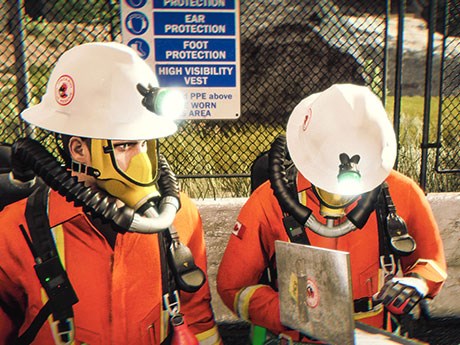Computer gaming technology leveraged for training mine rescue volunteers
There’s a new mine in Ontario, but it doesn’t produce any ore. Rubicon Minerals’ Phoenix Gold Mine would be a good guess, but this mine is the product of computer gaming technology and is made up of bits and bytes.
Ferdeno was dreamed up by the Northern Centre for Advanced Technology (NORCAT), and Ed Wisniewski, its director of software development and information technology in response to a request from Dynamic Earth, Sudbury’s geoscience centre, for an interactive display with a mine rescue theme.
As the virtual mine took shape, Wisniewski wondered if it could also be developed as a training tool for real mine rescue volunteers.
“We were really proud of what we built, so we met with Ontario Mine Rescue and said, ‘Hey isn’t this cool?’ They said, ‘Ya, but that’s not how it works.’ We learned it was a little more complicated, so we had our artist, Andrew Kostuik, participate in some real mine rescue training,” said Wisniewski.
After three weeks of immersion in the real world of mine rescue, Kostuik had a much better idea of how to build a computer game that could be used as a training tool.
“We had to be careful with it though because it’s perceived as a game and for the mining industry and the unions, health and safety is not a game, so it was a bit of a challenge for us to break that mold,” said Wisniewski. On the other hand, “we felt we have to start using this kind of technology because this is how the young generation learns.”
Wisniewski and Kostuik took four months to build it.
“We didn’t sleep a lot, partially because it’s our passion… we lived and breathed it,” said Wisniewski. “
Ferdeno is accessed via a portal, has a network of drifts, a refuge station, an electrical substation and ventilation doors. There’s a team of mine rescuers equipped with personal protective equipment, fire extinguishers, first aid kits and stretchers. There’s dialogue, sound effects and emergency scenarios trainees are confronted with and respond to using gaming joysticks. As with other computer games, they earn “achievements” when they choose the correct fire extinguisher, for example, and use it in the prescribed manner.
“It’s similar to your typical Call of Duty shoot ’em up game,” said Wisniewski. “The only difference is we take the weapons away and wrap it in education, and health and safety. Instead of a gun, you get a fire extinguisher.”
Because it’s against the law to deliberately start a fire in an underground mine, trainers will sometimes use Christmas tree lights to simulate a fire, said Wisniewski. In the gaming scenario, the fire is also simulated, but it looks real, crackles and produces smoke.
Inverse kinematic (IK) suits and virtual reality goggles can take computer simulation training a giant step further. With 27 sensors strategically positioned at wrists, elbows, shoulders and other joints in the suit and wirelessly communicating with the corresponding joints or “bones” of the mine rescue characters, a trainee becomes the mine rescue character and is inside the make-believe mine. If the trainee raises his arm, so does the character. However, taking this next step to virtual reality technology will be prohibitive in the near term due to the cost of providing mine rescue teams across the province with IK suits, said Wisniewski.
A more basic version of NORCAT’s mine rescue simulation exhibit is up and running at Dynamic Earth and Ontario Mine Rescue has expressed an interest in exploring the use of virtual scenario-based learning for its 900 volunteers around the province, but the work done to date has many more applications and has attracted interest beyond the mining industry.
Ferdeno has already been built. With the creation of additional characters and equipment, it can be used for site orientations, and to teach scaling, circle checks, or hazard identification. Ferdeno was also leveraged to demonstrate Jannatec Technologies’ collision avoidance technology at MINExpo.
Wisniewski credits social media for several surprise inquiries – one from CP Rail expressing an interest in using the technology for yard work training, and another from the Hess Corporation, for training workers on offshore oil platforms.
Click here to watch a video of a mine rescue team responding to an emergency at the Ferdeno Mine.



